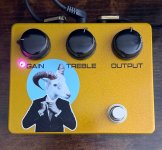smalltownsongs
New member
Hey all!
Well over 50 builds under my belt, including quite a few klones, but this is my first self-unsolvable issue, so I figured I'd post up and graciously ask if y'all could see something I'm just missing.
Engaged, it's loud and sounds pretty good (I might say it's not as overdriven as I'm used to though), and in bypass it's muffled, and the signal is just fighting to get through. It has some crackle to the lower turns of the gain pot. I did have this boxed up and it had the same issues (verified it wasn't the gain pot grounding out), but de-boxed for reflow and pics.
What I've done:
- Visually checked and verified I had the right values (feel free to double or triple check me tho! that all-tan-no-bands fella is the 422k, have used em before).
- Visually checked for hairline solder bridges or anything touching.
- Reflowed all solder joints
- Measured voltage of the IC chips
Pics:






IC Voltages:
1044
I was planning on picking up another Kliche bypass breakout board and redoing that and the switch to see if that would help, but was waiting to place a larger order to make it worthwhile. Def don't want to true bypass it.
Any and all help and guidance is appreciated!
Well over 50 builds under my belt, including quite a few klones, but this is my first self-unsolvable issue, so I figured I'd post up and graciously ask if y'all could see something I'm just missing.
Engaged, it's loud and sounds pretty good (I might say it's not as overdriven as I'm used to though), and in bypass it's muffled, and the signal is just fighting to get through. It has some crackle to the lower turns of the gain pot. I did have this boxed up and it had the same issues (verified it wasn't the gain pot grounding out), but de-boxed for reflow and pics.
What I've done:
- Visually checked and verified I had the right values (feel free to double or triple check me tho! that all-tan-no-bands fella is the 422k, have used em before).
- Visually checked for hairline solder bridges or anything touching.
- Reflowed all solder joints
- Measured voltage of the IC chips
Pics:






IC Voltages:
1044
- 9.45
- 4.81
- .2
- -4.44
- -9.04
- 4.50
- 5.99
- 9.45
- 4.02
- 3.55
- 3.55
- -9.04
- 3.54
- 3.54
- 3.06
- 17.05
- 2.91
- 2.91
- 1.16
- .1
- 2.53
- 2.50
- 2.30
- 9.45
I was planning on picking up another Kliche bypass breakout board and redoing that and the switch to see if that would help, but was waiting to place a larger order to make it worthwhile. Def don't want to true bypass it.
Any and all help and guidance is appreciated!

